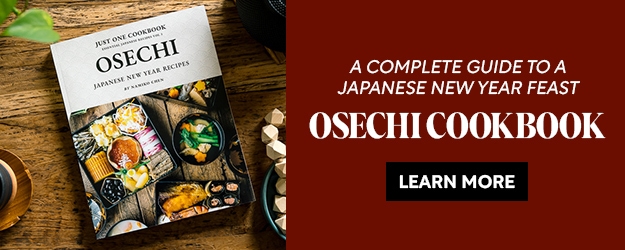Kansai-style Ozoni is a miso-based mochi soup enjoyed for breakfast on New Year’s Day in Japan. It is one of the most iconic dishes of Osechi Ryori, or traditional Japanese New Year foods. This adaptation of my mom’s plant-based recipe includes leafy green vegetables.
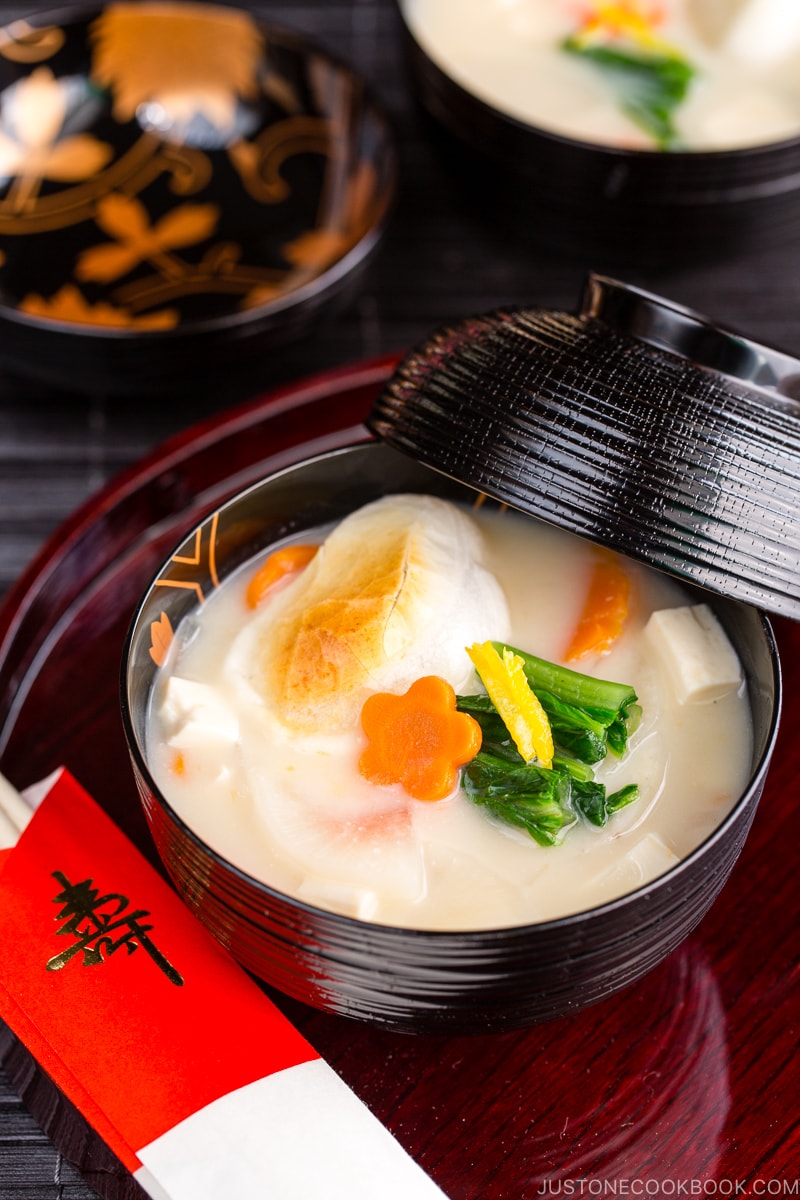
The Japanese celebrate the New Year by feasting on Osechi Ryori (お節料理), traditional Japanese New Year food packed in lacquered boxes along with this special mochi soup called Ozoni (お雑煮).
What is Ozoni?
Ozoni is a special soup that we eat in the morning on New Year’s Day in Japan. It usually includes mochi (rice cake) and the preparation varies by household and region.
There are numerous regional variations in Japan but we usually divide into two types – the Kanto (Tokyo area) style and the Kansai (Kyoto area) style.
Ozoni Soup
- The Kanto, Chugoku, and Kyushu regions: a clear miso soup flavored with bonito-based dashi and soy sauce.
- The Kansai and Shikoku regions: white miso is added to the kombu base dashi soup.
- Some areas in Tottori prefecture: the azuki red bean soup with round mochi.
Mochi
- The Kanto region: a rectangular-shaped mochi is grilled/toasted before being added to the soup.
- The Kansai region: a round-shaped mochi is cooked in boiling water before being added to the soup.
Over 400 years ago, round mochi was commonly used throughout Japan. However, as more people started to live in the Tokyo area, it was too much work to make the mochi into a round shape by hand. Therefore big mochi cake was cut into small squares and they became the common shape in the Kanto region.
Ingredients in Ozoni
- The Kanto style: chicken, fish cakes, dried shiitake, carrot, and some leafy vegetables like komatsuna, spinach, or mitsuba are often included in the soup and garnished with yuzu peel.
- The Kansai style: ozoni, satoimo (taro root), daikon, and carrot are the common ingredients and are often garnished with katsuobushi (bonito flakes) on top.
- Others: Some regions close to the ocean include fish and seafood, while mountain regions use vegetables and mushrooms. The additions to the soup vary based on the regional and seasonal ingredients.
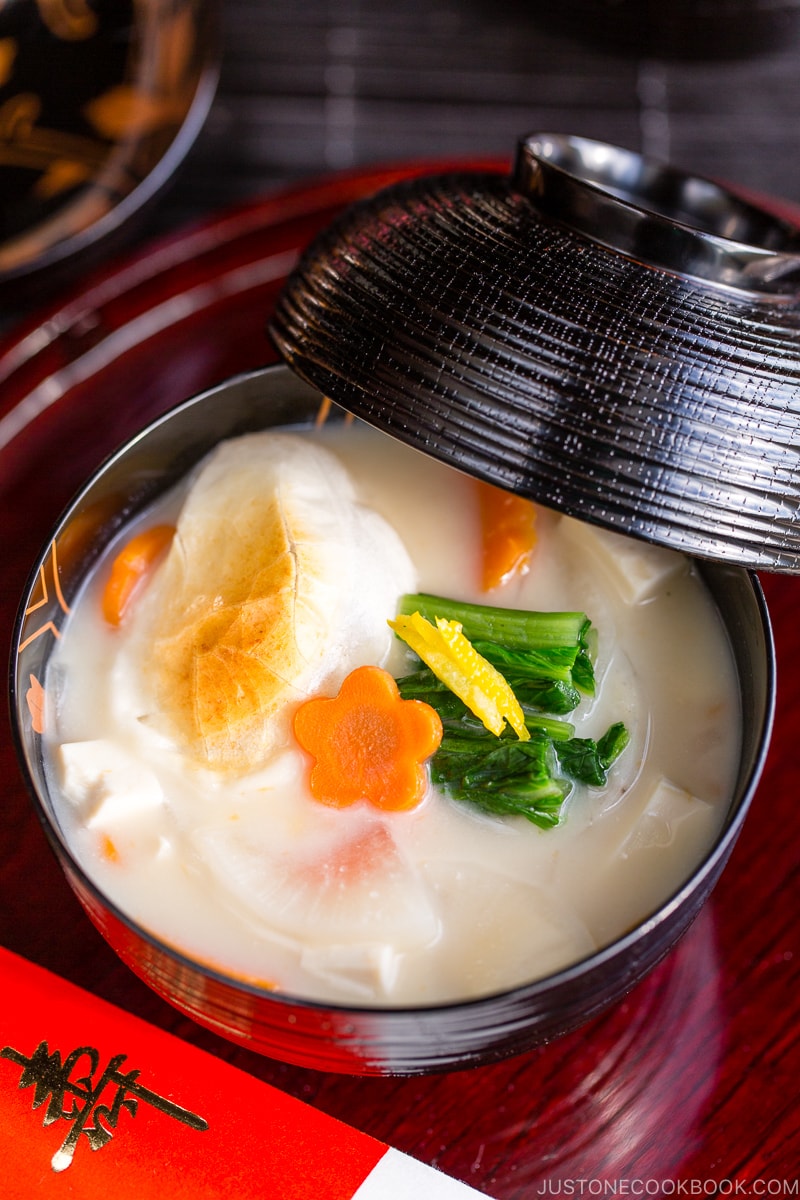
My Family’s Ozoni
As I mentioned earlier, this new year’s soup not only varies by region but also by each household.
My mother lived in Osaka before she moved to Tokyo for college. Her mother’s family was originally from Kyoto and her dad’s family was from Nara. Therefore, my mom’s family grew up eating Kansai-style Ozoni. On the other hand, my dad grew up in Tokyo eating Kanto-style Ozoni till he met my mom.
So, my mom’s ozoni is a mix of both, with the Kansai-style base. It includes 5 ingredients: satoimo (taro root), daikon, Kyoto-style carrot (it’s red more than orange), toasted round mochi, and tofu. She uses Saikyo Miso (white miso from Kyoto).
For my version, I add leafy green vegetables (komatsuna or spinach) and yuzu peel, both of which are the common ingredients for Kanto-style ozoni. The green color added to the soup makes it prettier and I also like to add the fragrance of yuzu peel if I am lucky enough to get fresh yuzu.
My children didn’t like ozoni when they were little, but now they love the Kansai-style and I’m so excited that we can enjoy this traditional food as a family.
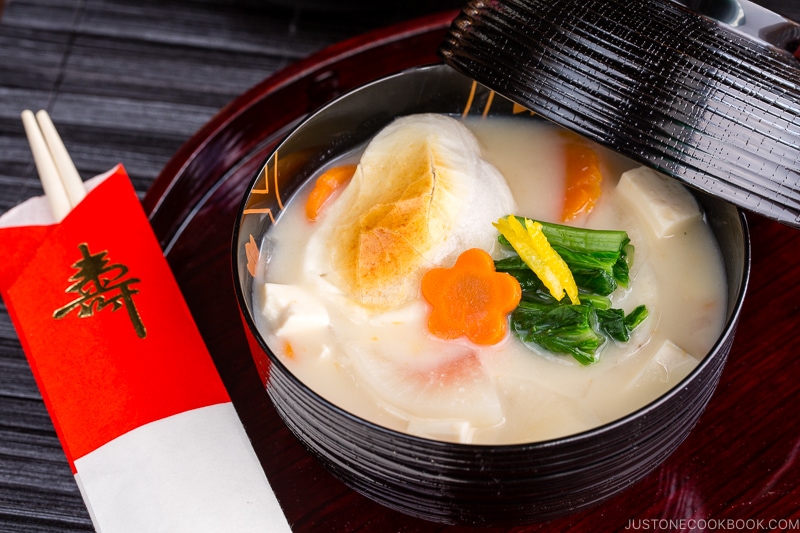
How to Make Kansai-style Mochi Soup
The Ingredients You’ll Need
The Cooking Steps
- Soak the kombu for a minimum of 20–30 minutes or overnight in water to make Cold Brew Kombu Dashi.
- Cut the vegetables (taro, daikon, and carrot) according to the instructions.
- Cook the vegetables in the cold brew kombu dashi until they are tender. Add more water if too much liquid has evaporated.
- Blanch komatsuna until tender in a separate saucepan. Cut the cooked komatsuna into smaller pieces. Set aside. Prepare yuzu zest (optional).
- When the vegetables are cooked, dissolve Saikyo miso into the soup. Cut the soft/silken tofu into small cubes and gently add them to the soup without breaking it. Reheat the soup until it is just hot, turn off the heat, and keep it covered.
- Place the round mochi (rice cake) directly on the rack of a toaster oven and toast until puffy. You can also toast the mochi over an open flame, under a broiler, or in a frying pan.
- Serve the soup in individual serving bowls. Add one piece of toasted mochi on top of the soup in each bowl. Serve immediately with the colorful toppings on the side.
Saikyo Miso in Kansai-style Ozoni
If you are new to Saikyo Miso (西京味噌), it’s different from regular white miso and it’s naturally sweet.
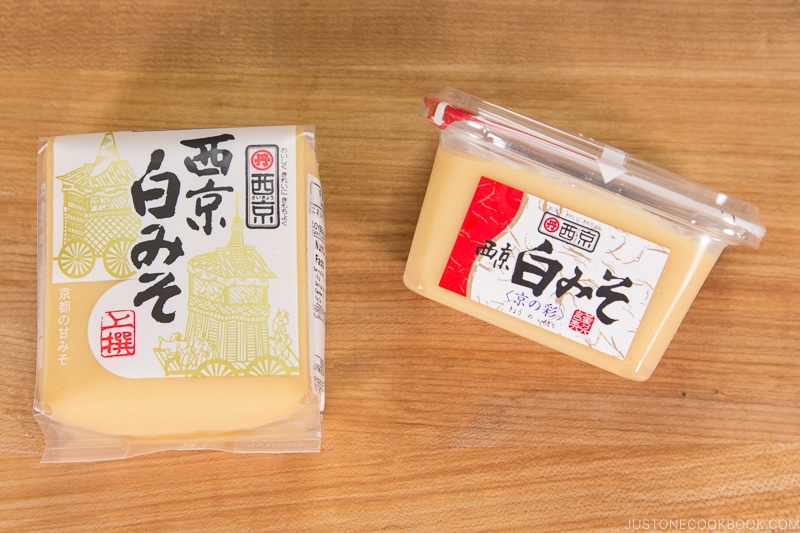
The sweet flavor is similar to amazake (甘酒). This sweetness comes from the sugar produced through the fermentation process. Saikyo miso is made in Kyoto and it’s usually more expensive than regular miso. You might have tasted this special miso if you had fish called Gindara Saikyo Yaki (or known as Miso Cod here in the US). You can find saikyo miso in a Japanese supermarket.
Kanto-style Ozoni
People in the Tokyo area enjoy mochi soup with a clear broth. If you’re interested in Kanto-style Ozoni with white miso, check out the video and recipe with step-by-step pictures.
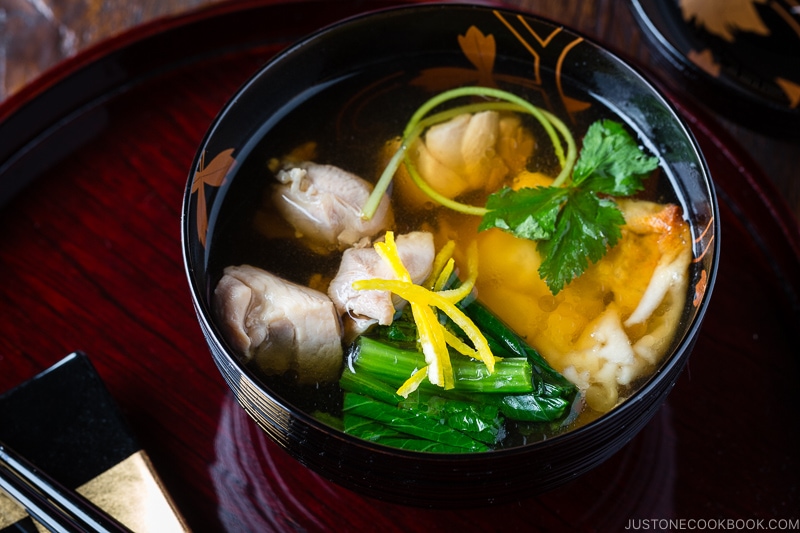
Wish to learn more about Japanese cooking? Sign up for our free newsletter to receive cooking tips & recipe updates! And stay in touch with me on Facebook, Pinterest, YouTube, and Instagram.
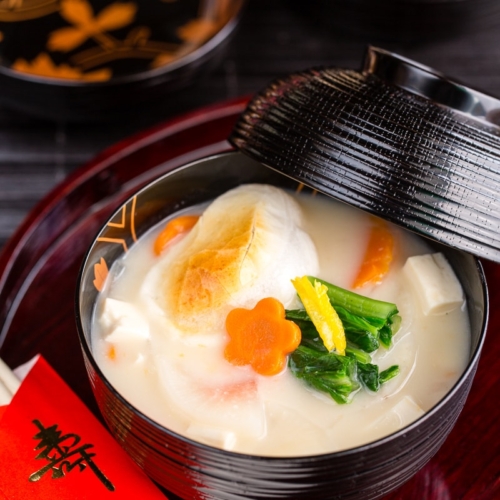
Ozoni (Japanese New Year Mochi Soup – Kansai Style)
Kansai-style Ozoni is a miso-based mochi soup enjoyed for breakfast on New Year’s Day in Japan. It is one of the most iconic dishes of Osechi Ryori, or traditional Japanese New Year foods. This adaptation of my mom‘s plant-based recipe includes leafy green vegetables.
Ingredients
Prevent your screen from going dark
Instructions
-
Before You Start: Please note that this recipe requires cold brewing the Kombu Dashi preferably overnight or at least 4–5 hours. In a pinch, you can steep it for 20–30 minutes and make Kombu Dashi on the stovetop.I recommend prepping this recipe the day before you plan to serve. The next day, reheat the soup and add the miso and mochi just before serving. For more helpful tips on planning your Japanese New Year feast, please read my A 5-Day Osechi Cooking Timeline blog post.
-
Gather all the ingredients. Most Japanese recipes say to gently clean the kombu with a damp cloth. However, these days, kombu is pretty clean. Just make sure it doesn‘t have any mold spots and it‘s ready to use. Do not wash or wipe off the white powdery substance, as it has lots of umami.
To Make the Kombu Dashi
-
To make the dashi stock, put 3 cups water and 1 piece kombu (dried kelp) in a large pot. For the best flavor, make cold brew Kombu Dashi and let it steep overnight on the counter (or in the refrigerator during warm weather). If you‘re short on time, you can steep it for at least 4–5 hours in the wintertime (or 2–3 hours in the summertime). In a pinch, soak the kombu for a minimum of 20–30 minutes and then make Kombu Dashi on the stovetop.
To Prepare the Ingredients
-
Peel 2 pieces taro (satoimo) and slice it into rounds ⅛ inch (3 mm) thick. Soak the slices in a bowl of water to remove the slimy texture.
-
Peel 2 inches daikon radish and slice it into rounds ⅛ inch (3 mm) thick. If it’s a large daikon, cut it in quarters lengthwise, then slice.
-
Peel 3 inches carrot and slice it into rounds ⅛ inch (3 mm) thick. If you‘d like to decorate the soup with a carrot flower (called hanagiri), cut out some of the round slices into a floral shape. Keep the carrot rounds and flower-shaped pieces in different bowls, as you will cook them separately.
To Cook the Soup
-
To the pot filled with the kombu dashi, add the satoimo (taro), daikon, and carrot rounds. Set the pot over medium-high heat and bring it to a boil. Right before the water reaches a boil, remove the kombu. Tip: If you leave the kombu in the pot, the stock will become slimy and bitter. With the spent kombu, you can make Simmered Kombu (Kombu Tsukudani) or Homemade Furikake (Rice Seasoning).
-
Skim off the foam (from the satoimo) from the surface of the soup with a fine-mesh strainer. Lower the heat to medium low and cover with a lid slightly ajar. Simmer until the vegetables are tender. Add more water if too much liquid has evaporated.
-
Meanwhile, cut 2 stalks komatsuna (or spinach) in half. Set a saucepan of water on the stove over medium-high heat. If you prepared carrot flower slices (optional), add them to the water. Bring the water to a boil. Then, add the komatsuna and cook until tender.
-
Remove the komatsuna and carrot when they are tender and drain them. Cut the komatsuna into smaller pieces (1½ inches, 3 cm). Set these aside to serve as toppings later.
-
While the taro and daikon continue to cook, prepare the yuzu zest (optional). Peel 2 or 3 thick strips of zest from the yuzu skin. Flip the pieces over and remove any white pith. Then, slice the strips of yuzu zest into thin julienned strips. Place on a small dish and set aside to serve as garnish later.
-
Once the vegetables in the soup are tender, turn off the heat. Next, completely dissolve 3 Tbsp of the 3–5 Tbsp Saikyo miso (Kyoto-style white miso) into the soup. Taste the soup; if it needs more miso, add 1 Tbsp at a time until you’re satisfied with the flavor. (My family likes thick soup, so I tend to add more.) Once you‘re done stirring in the miso, cut 7 oz soft/silken tofu (kinugoshi dofu) into ½-inch (1.3-cm) cubes and gently add it to the soup without breaking it. Reheat the soup until it is just hot, turn off the heat, and keep it covered. Tip: Do not boil the soup because the miso will lose nutrients, flavor, and aroma.
-
Once the soup and toppings are ready, place 4 pieces round mochi (rice cake) directly on the rack of a toaster oven and toast until puffy. You can also toast the mochi over an open flame, under a broiler, or in a frying pan.
Nutrition
Nutrition Facts
Ozoni (Japanese New Year Mochi Soup – Kansai Style)
Amount per Serving
% Daily Value*
* Percent Daily Values are based on a 2000 calorie diet.
Editor’s Note: This post was originally published on December 28, 2014. It’s been republished on December 24, 2023.


